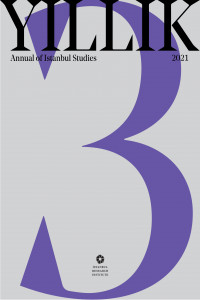Öz
In many ways, we continue to teach the same propagandistic view of Hagia Sophia provided to us by Prokopios. Culling from Prokopios’s meticulous account of the construction, art historical surveys detail with narrative intrigue the various struggles faced by the builders and the marvels of Anthemios of Tralles and Isidoros of Miletos’s design and engineering. Yet, we all too easily forget the thirty thousand citizens of Constantinople violently assassinated by Justinian’s army in the Hippodrome. And, we all too easily overlook the ways in which Hagia Sophia is not simply a byproduct of the Nika Riots’ rampage, but rather, a reassertion of imperial dominance over the city’s populace during a period in which Justinian’s rule faced much criticism for its brutal policies and practices. We are left to wonder how many people in attendance at the new church’s consecration, just a mere six years after the riot, had lost a loved one at the Hippodrome that day. Now, the skyline of Constantinople would be dominated by a poignant reminder of the riot and the lives lost, a fact that is easy to forget when we look at the building today.
Anahtar Kelimeler
Kaynakça
- Prokopios, Wars (1.24), ed. and trans. H.B. Dewing, History of the Wars, vol. 1 (Cambridge, MA: Harvard University Press, 1914), 218–239. On the number of dead, see Geoffrey Greatrex, “The Nika Riot: A Reappraisal,” Journal of Hellenic Studies 117 (1997): 60–86, at 79, n. 98.
- See Robert Ousterhout, Eastern Medieval Architecture: The Building Traditions of Byzantium and Neighboring Lands (New York: Oxford University Press, 2019), 201.
- Prokopios, On Buildings (1.1), ed. and trans., H.B. Dewing and Glanville Downey (Cambridge, MA: Harvard University Press, 1940), 10–11.
- See Howard Zinn, A People’s History of the United States: 1942–Present (New York: Harper and Row, 1980); Nikole Hannah-Jones, et al., “The 1619 Project,” New York Times Magazine (August 2019).
- Sharon Gerstel, Rural Lives and Landscapes in Late Byzantium: Art, Archaeology, and Ethnography (New York: Cambridge University Press, 2015).
- Roland Betancourt, Byzantine Intersectionality: Sexuality, Gender, and Race in the Middle Ages (Princeton: Princeton University Press, 2020).
- See Alan Cameron, Circus Factions: Blues and Greens at Rome and Byzantium (Oxford: Oxford University Press, 1976).
- Prokopios, The Anecdota or Secret History (2.12), ed. and trans. H.B. Dewing (Cambridge: Harvard University Press, 1935), 146–147. For an alternative translation and useful contextual materials, see Anthony Kaldellis, ed. and trans., The Secret History with Related Texts by Prokopios (Indianapolis: Hackett Publishing Company, 2010).
- For a brief survey of Hagia Sophia in the Ottoman world, see Gülru Necipoğlu, “The Life of an Imperial Monument: Hagia Sophia after Byzantium,” in Hagia Sophia: From the Age of Justinian to the Present, eds. Robert Mark and Ahmet Çakmak (Cambridge: Cambridge University Press,), 195–225. See also Çiğdem Kafescioğlu, Constaninopolis/Istanbul: Cultural Encounter, Imperial Vision, and the Construction of the Ottoman Capital (University Park: Pennsylvania State University Press, 2009).
- Cyril Mango and Ernest J.W. Hawkins, “The Apse Mosaics of St. Sophia at Istanbul: Report on Work Carried Out in 1964,” Dumbarton Oaks Papers 19 (1965): 115–151, at 125.
- Robert S. Nelson, Hagia Sophia, 1850–1950: Holy Wisdom, Modern Monument (Chicago: University of Chicago Press, 2004).
- Erik Goldstein, “Holy Wisdom and British Foreign Policy, 1918–1922: The Saint Sophia Redemption Agitation,” Byzantine and Modern Greek Studies 15 (1991): 36–64.
Öz
Kaynakça
- Prokopios, Wars (1.24), ed. and trans. H.B. Dewing, History of the Wars, vol. 1 (Cambridge, MA: Harvard University Press, 1914), 218–239. On the number of dead, see Geoffrey Greatrex, “The Nika Riot: A Reappraisal,” Journal of Hellenic Studies 117 (1997): 60–86, at 79, n. 98.
- See Robert Ousterhout, Eastern Medieval Architecture: The Building Traditions of Byzantium and Neighboring Lands (New York: Oxford University Press, 2019), 201.
- Prokopios, On Buildings (1.1), ed. and trans., H.B. Dewing and Glanville Downey (Cambridge, MA: Harvard University Press, 1940), 10–11.
- See Howard Zinn, A People’s History of the United States: 1942–Present (New York: Harper and Row, 1980); Nikole Hannah-Jones, et al., “The 1619 Project,” New York Times Magazine (August 2019).
- Sharon Gerstel, Rural Lives and Landscapes in Late Byzantium: Art, Archaeology, and Ethnography (New York: Cambridge University Press, 2015).
- Roland Betancourt, Byzantine Intersectionality: Sexuality, Gender, and Race in the Middle Ages (Princeton: Princeton University Press, 2020).
- See Alan Cameron, Circus Factions: Blues and Greens at Rome and Byzantium (Oxford: Oxford University Press, 1976).
- Prokopios, The Anecdota or Secret History (2.12), ed. and trans. H.B. Dewing (Cambridge: Harvard University Press, 1935), 146–147. For an alternative translation and useful contextual materials, see Anthony Kaldellis, ed. and trans., The Secret History with Related Texts by Prokopios (Indianapolis: Hackett Publishing Company, 2010).
- For a brief survey of Hagia Sophia in the Ottoman world, see Gülru Necipoğlu, “The Life of an Imperial Monument: Hagia Sophia after Byzantium,” in Hagia Sophia: From the Age of Justinian to the Present, eds. Robert Mark and Ahmet Çakmak (Cambridge: Cambridge University Press,), 195–225. See also Çiğdem Kafescioğlu, Constaninopolis/Istanbul: Cultural Encounter, Imperial Vision, and the Construction of the Ottoman Capital (University Park: Pennsylvania State University Press, 2009).
- Cyril Mango and Ernest J.W. Hawkins, “The Apse Mosaics of St. Sophia at Istanbul: Report on Work Carried Out in 1964,” Dumbarton Oaks Papers 19 (1965): 115–151, at 125.
- Robert S. Nelson, Hagia Sophia, 1850–1950: Holy Wisdom, Modern Monument (Chicago: University of Chicago Press, 2004).
- Erik Goldstein, “Holy Wisdom and British Foreign Policy, 1918–1922: The Saint Sophia Redemption Agitation,” Byzantine and Modern Greek Studies 15 (1991): 36–64.
Ayrıntılar
| Birincil Dil | İngilizce |
|---|---|
| Konular | Sosyal Bilimlerin Tarihi |
| Bölüm | Meclis |
| Yazarlar | |
| Yayımlanma Tarihi | 30 Aralık 2021 |
| Gönderilme Tarihi | 10 Eylül 2021 |
| Yayımlandığı Sayı | Yıl 2021 Cilt: 3 |


